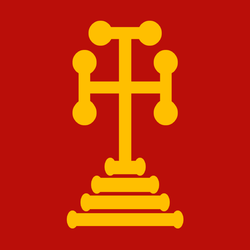Arminiya
| Ostikanát Arminiya Արմինիա ոստիկանություն
| |||||||||||||||||
Geografie
| |||||||||||||||||
Dvin | |||||||||||||||||
| Obyvatelstvo | |||||||||||||||||
Národnostní složení | |||||||||||||||||
| Státní útvar | |||||||||||||||||
| Státní útvary a území | |||||||||||||||||
| |||||||||||||||||
Arminiya, běžně známa jako Arménský ostikanát (Արմինիա ոստիկանություն, Arminia vostikanut'yun) nebo v arabštině označovaná jako emirát (arabsky إمارة أرمينيا, imārat Arminiya) byla autonomní region a provincie Umajjovského a později Abbásovského chalífátu existující v letech 654–884, bylo obdobím arabské nadvlády.
Od 5. století sloužili Arméni jako hlavní složka v řadách byzantské armády, s gustem bojovali proti Peršanům s cílem osvobodit své souvěrce z perské Arménie. Byli považováni za obzvlášť spolehlivé, protože mnoho z nich tvořilo stráž v císařském paláci. Tohoto cíle se podařilo dosáhnout roku 591, kdy Byzanc Peršany definitivně porazila a ovládla většinu arménského území. Byzantský císař Maurikios pak podpořil chalcedonskou frakci uvnitř Arménské apoštolské církve, aby došlo ke sblížení s byzantskou ortodoxií. Roku 645 však Arménii dobyli Arabové a učinili z ní provincii chalífátu pod názvem Arminiya. Ačkoli arabští chalífové zprvu dovolili arménskému knížeti, aby region spravoval jako autonomní celek výměnou za vyplácení tributu a loajalitu Arménů v časech války, chalífa Abd al-Malik ibn Marwan zavedl přímou arabskou nadvládu v čele s ostikanem se svým hlavním městem ve Dvinu. Vyšší míru suverenity Arménie znovu získala až v osmdesátých letech 9. století pod vládou dynastie Bagratovců.
Odkazy
Reference
Související články
Média použitá na této stránce
Artist's rendition of the banner of the late Sassanid Empire.
Autor: Ec.Domnowall (vectorisation SVG), Licence: CC BY-SA 3.0
Ancient Georgian (Iberian) Flag during King Gorgasali reign in 5c. AD. The flag was also used by the Principality of Iberia (lately Tao-Klarjeti) and its legal successor the Kingdom of The Georgians
No official flag.
Autor: Constantine Plakidas, Licence: CC BY-SA 4.0
Political map of the Caucasus, c. 740 CE, following the end of the Arab-Khazar conflict and the consolidation of Umayyad power in Transcaucasia.
Sources: Inspired by File:Kaukasus 750n de.svg, as an attempt to improve it and correct some errors and omissions. Background map taken from File:Caucasus_topographic_map-fr.svg.
Literature and maps consulted:
- Khalid Yahya Blankinship (1994). The End of the Jihâd State: The Reign of Hishām ibn ʻAbd al-Malik and the Collapse of the Umayyads. Albany, NY: State University of New York Press. ISBN 978-0-7914-1827-7
- William C. Brice (1981). An Historical Atlas of Islam. Leiden: E. J. Brill. ISBN 90-04-06116-9, p. 44 "Caucasus (Al-Qabq) in the Early Middle Ages"
- M. I. Artamonov (1962). История хазар. Издательство Государственного Эрмитажа, p. 200 Map 'The Caucasus in the 7th-8th centuries'
- Map "Armenia, 654-750 A.D." from armenica.org.
Autor: Dragovit, Licence: CC BY-SA 4.0
The Byzantine "Calvary cross potent" as icon or hypothetical banner of the Byzantine Empire. The Calvary cross standing on a number of steps was minted on solidus coins (also shows without the steps on tremissis coins) by various Byzantine emperors, mainly in the 7th century during the reign of Heraclian dynasty and after.
Autor: Gegart, Licence: CC BY-SA 3.0
Flag of Armenian royal Bagratuni dynasty (according to armenianchurchofmetrowest.org The tradition of a Bagratuni lion-with-cross standard appears to be modern (Soviet-era?), apparently based on a relief of a lion on the gates of the medieval Armenian capital of Ani[1] and/or the depiction of a throne supported by lions[2]
A flag used during the Umayyad dynasty (660–750)
Flag which can be used to represent the Abbasid Caliphate. Note that the concept of rectangular national flags did not exist during Abbasid times, but black was the dynastic color of the Abbasids (just as green was the dynastic color of the Fatimids, etc.), and the "black banner" of the Abbasids is famous in Islamic history.








